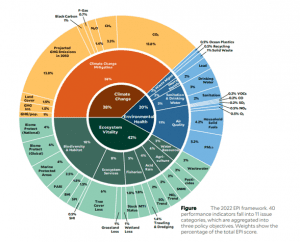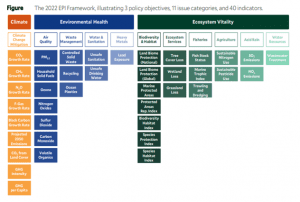DAILY CURRENT AFFAIRS (AUGUST 18, 2022)
THE INDIAN POLITY AND GOVERNANCE
1. INDIA’S ‘PANCH PRAN’ TARGET FOR NEXT 25 YEARS
THE CONTEXT: On August 15, 2022, Prime Minister addressed the nation for 9th consecutive time from the Red Fort. During the 88 minutes speech, PM set a “PanchPran Targets” (Five Resolves) to turn India into a developed nation in next 25 years, when India will celebrate 100th Independence Day.
THE EXPLANATION:
Standards of Developed India:
• Standards of developed India include- cleanliness campaign, vaccination, electricity connection, open defecation free, use of solar energy for developed India.
• New National Education Policy is an example of “freedom from the thought of slavery”.
• India First, Gender equality, and respect for women are symbols of unity and solidarity in country.
• Fulfilling duties such as saving electricity, chemical-free farming and full use of water available in the fields will bring progress in India.
The Five Resolves that PM asked people to take include;
1. Move forward with bigger resolves and resolve of a developed India
2. Erase all traces of servitude
3. Be proud of India’s legacy
4. Strength of unity
5. Duties of citizens including PM and CMs.
According to PM, these five resolves will be significant for a developed country when country will mark 100 years of independence in 2047. These five resolves also include the PM’s dream of ‘Vishwaguru India’. The Prime Minister seeks to make India “Vishwaguru” on completion of 100 years of independence.
THE INTERNATIONAL RELATIONS
2. MOSCOW CONFERENCE ON INTERNATIONAL SECURITY-2022
THE CONTEXT: The Moscow Conference on International Security-2022 was held from August 15 to August 17, 2022. Defence Minister addressed the plenary session conference virtually on August 16.
THE EXPLANATION:
Highlights of Defence Minister’s address:
• In his address, Defence Minister stressed on brining comprehensive reform in structure of United Nations.
• He noted that, worrying shortcoming in system of United Nations highlights its structural inadequacy.
• Reform of the United Nations Security Council (UNSC) lies at the base of India’s call for “reformed multilateralism”. He expressed that, UNSC must be turned into more representative organisation for developing countries, to provide leadership worldwide.
• He also highlighted the potential geopolitical fault-line in maritime domain, specifically in East Asia. According to him, it could get bigger than what world is witnessing today.
• Regarding the Indo-Pacific region, he notes- India, is committed to free, open, inclusive and secure Indo-Pacific region, being a central country to Indian Ocean.
The Moscow Conference on International Security-2022 was attended by Ministers of Defence from different countries, besides the experts and key stakeholders from military field. These conferences on international security are organised with the objective of sharing practical ideas and exploring solutions on issues of global security. Conferences also give opportunity to defence ministers to engage with their counterparts on security issues.
THE ENVIRONMENT, ECOLOGY AND CLIMATE CHANGE
3. ‘DELHI’S PM2.5 LEVELS WORST IN THE WORLD’
THE CONTEXT: A recent Air Quality and Health in Cities, released by U.S.-based Health Effects Institute, analyses pollution and global health effects for more than 7,000 cities around the world, focusing on two of the most harmful pollutants – fine particulate matter (PM2.5) and nitrogen dioxide (NO2).
THE EXPLANATION:
• A global analysis of air quality found that Indian cities, while recording particulate matter emissions (PM2.5) that are among the highest in the world, do relatively better on nitrogen dioxide (NO2) emissions.
• The report, using data from 2010 to 2019, found that global patterns for exposures to the two key air pollutants were “strikingly different.” While exposures to PM2.5 pollution tend to be higher in cities located in low- and middle-income countries, exposure to NO2 is high across cities in high-income as well as low- and middle-income countries.
• Delhi and Kolkata were ranked first and second in the list of top 10 most polluted cities when PM2.5 levels were compared, with Delhi and Kolkata reporting an average annual exposure of (relative to population) of 110 ug/m3 and 84 ug/m3 respectively. ug/m3 refers to microgram per cubic metre.
• However no Indian city appeared in the list of top 10 – or even top 20 – polluted cities when N02 levels were compared. This list saw Shanghai at the top with an average annual exposure of 41 ug/m3. Average NO2 levels for Delhi, Kolkata and Mumbai, according to the report, ranged from 20-30 ug/m3.
• NO2 comes mainly from the burning of fuels in older vehicles, power plants, industrial facilities and residential cooking and heating.
• As city residents tend to live closer to busy roads with dense traffic, they are often exposed to higher NO2 pollution than residents of rural areas.
• In 2019, 86% of the more than 7,000 cities analysed in the report exceeded the WHO’s 10 ug/m3 guideline for NO2, impacting about 2.6 billion people.
• “While PM2.5 pollution tends to get more attention on known hotspots around the world, less data has been available for NO2 at this global scale,” the report notes.
• An expert says, that this paradoxical situation in India was likely due to the relatively lower adoption of high-efficiency engine vehicles. “Complete combustion of fuel results in higher NOx (nitrogen oxides) where incomplete combustion sees other kinds of emissions”. Other cities with high NO2 population levels included Moscow, Beijing, Paris, Istanbul and Seoul.
• Due to their highly reactive nature, nitrogen oxides also contributed to the formation of other pollutants, including ozone and particulate matter. NO2 also has a shorter lifetime compared with PM2.5 and other air pollutants. As a result, NO2 levels show very high variability in space and time — levels can vary significantly even across a few kilometres. In comparison, PM2.5 levels tend to show less spatial variation.
• In 2019, the global average NO2 exposure was 15.5 ug/m3, but exposure levels varied considerably across cities.
• Ground monitoring of air quality remains limited in many regions of the world, the report adds, obscuring the true degree of NO2 pollution in countries such as India.
VALUE ADDITION:
GOVERNMENT MEASURES:
National Clean Air Programme (NCAP):
• The MoEFCC launched it in January 2019.
• It is the first-ever effort in the country to frame a national framework for air quality management with a time-bound reduction target.
• It seeks to cut the concentration of coarse (particulate matter of diameter 10 micrometre or less, or PM10) and fine particles (particulate matter of diameter 2.5 micrometres or less, or PM2.5) by at least 20% in the next five years, with 2017 as the base year for comparison.
• The plan includes 102 non-attainment cities across 23 states and Union territories, which were identified by the Central Pollution Control Board (CPCB) on the basis of their ambient air quality data between 2011 and 2015.
• Non-attainment cities: These have fallen short of the National Ambient Air Quality Standards (NAAQS) for over five years.
National Ambient Air Quality Standards (NAAQS):
• Air (Prevention and Control of Pollution) Act empowers Central Pollution Control Board to set standards for the quality of air.
• Current NAAQS were notified by CPCB in the year 2009.
• Pollutants covered under NAAQS are Sulphur Dioxide (SO2), Nitrogen Dioxide (NO2), Particulate Matter (PM 10, PM 2.5), Ozone (O3), Lead (Pb), Carbon Monoxide (C.O.), Ammonia (NH3), Benzene (C6H6), Benzo(a)Pyrene (BaP), Arsenic(As), Nickel (Ni).
National Air Quality Index:
• Launched in 2014 without line‘One Number – One Color -One Description’ for the common man to judge the air quality within his vicinity.
• The measurement of air quality is based on eight pollutants, namely: Particulate Matter (PM10), Particulate Matter (PM2.5), Nitrogen Dioxide (NO2), Sulphur Dioxide (SO2), Carbon Monoxide (C.O.), Ozone (O3), Ammonia (NH3), and Lead (Pb).
• AQI has six categories of air quality. These are Good, Satisfactory, Moderately polluted, Poor, Very Poor and Severe.
• It has been developed by the CPCB in consultation with IIT-Kanpur and an expert group comprising medical and air-quality professionals.
THE SCIENCE AND TECHNOLOGY
4. 3D-PRINTED CORNEA FROM HUMAN DONOR CORNEAL TISSUE
THE CONTEXT: In a first event, researchers successfully developed the 3D-printed artificial cornea from human donor corneal tissue. Artificial cornea was transplanted into a rabbit eye.
THE EXPLANATION:
• This project was undertaken by researchers from L V Prasad Eye Institute (LVPEI), Hyderabad in association with the Indian Institute of Technology Hyderabad and Centre for Cellular & Molecular Biology, Hyderabad.
• It has been developed indigenously, with the help of government and philanthropic funding.
Artificial Cornea:
• Artificial cornea is completely natural and have no synthetic components.
• It is free from animal residues. It was also found to be safe for use in patients.
• This cornea was developed using bio-ink, which can be used by army-personnel for sight-saving at the site of injury by sealing corneal perforation. It will also prevent any infection during war-related injuries.
• It will also be sight-saving in remote area, that have no tertiary eye care facility.
Cornea is the front layer of eye. It helps is focusing light and helps in clear vision. But corneal damage has become a leading cause of blindness across the world. Globally, 1.5 million new cases of corneal blindness are reported every year. Thus, development of 3D-printed artificial cornea is significant for treating the diseases like corneal scarring.
THE GOVERNMENT SCHEMES IN NEWS
5. REVISION SERIES: NATIONAL ACTION FOR MECHANISED SANITATION ECOSYSTEM (NAMASTE)
Namaste is a Central Sector Scheme of the Ministry of Social Justice and Empowerment (MoSJE) as a joint initiative of the MoSJE and the Ministry of Housing and Urban Affairs (MoHUA).
• NAMASTE envisages safety and dignity of sanitation workers in urban India by creating an enabling ecosystem that recognizes sanitation workers as one of the key contributors in operations and maintenance of sanitation infrastructure thereby providing sustainable livelihood and enhancing their occupational safety through capacity building and improved access to safety gear and machines.
• Ensure safety and dignity of sanitation workers in urban India and providing sustainable livelihood and enhancing their occupational safety through capacity building and improved access to safety gear and machines.
• NAMASTE would also aim at providing access to alternative livelihoods support and entitlements to reduce the vulnerabilities of sanitation workers and enable them to access self-employment and skilled wage employment opportunities and break the intergenerationality in sanitation work.
In addition, NAMASTE would bring about a behavior change amongst citizens towards sanitation workers and enhance demand for safe sanitation services.
NAMASTE aims to achieve the following outcomes:
• Zero fatalities in sanitation work in India
• All sanitation work is performed by skilled workers
• No sanitation workers come in direct contact with human faecal matter
• Sanitation workers are collectivized into SHGs and are empowered to run sanitation enterprises
• All Sewer and Septic tank sanitation workers (SSWs) have access to alternative livelihoods
• Strengthened supervisory and monitoring systems at national, state and ULB levels to ensure enforcement and monitoring of safe sanitation work
• Increased awareness amongst sanitation services seekers (individuals and institutions) to seek services from registered and skilled sanitation workers
Five hundred cities (converging with AMRUT cities) will be taken up under this phase of NAMASTE. The list of cities will be notified at an appropriate time. The category of cities that will be eligible are given below:
• All Cities and Towns with a population of over one lakh with notified Municipalities, including Cantonment Boards (Civilian areas),
• All Capital Cities/Towns of States/ Union Territories (UTs), not covered in 4(i),
• Ten Cities from hill states, islands and tourist destinations (not more than one from each State).
Enumeration:
• NAMASTE envisages identifying the Sewer/Septic Tank Workers (SSWs) with a focus on informal workforce who are engaged in hazardous cleaning operations. The database will enable MoSJE, NSKFDC and MoHUA (including DAY-NULM, SBM 2.0 and AMRUT) to reach to the SSWs and their families and provide them necessary support for collectivization, skill building and linking with social and financial benefits.
• The Survey would be conducted by the City NAMASTE Managers and validated by the concerned ULB. The survey would be held in digital mode in a pre-approved format.
THE PRELIMS PERSPECTIVE
6. ARUNACHAL PRADESH ‘MEDICINE FROM THE SKY’ PROJECT
THE CONTEXT: In Arunachal Pradesh, “Medicine from the Sky Project” was unveiled successfully on August 15, 2022. First flight of drone service was carried from Seppa to Chayang Tajo in East Kameng district. This project is inspired from the Prime Minister’s vision of transforming India into world’s drone hub.
THE EXPLANATION:
Highlights of the project:
• In Arunachal Pradesh, pilot project of using drones in healthcare, agriculture and disaster management including the “Medicine from the Sky project” is being undertaken in association with the World Economic Forum (WEF).
• Medicine from the Sky Project has been funded by the United States Agency for International Development (USAID).
• It is being implemented by Redwing Labs, which is a start-up based in Bengaluru.
• This project will provide a clear vision on operational issues, regulatory issues, and financial feasibility. On the basis of this, government will make a policy and take steps to adopt emerging technology in phased manner.
According to Civil Aviation Ministry, India is set to witness a high number of industries holding drone innovation in a bid to make India world’s drone hub by 2030. It will bring a revolution in line with the goal of an Aatmanirhar Bharat. Government will continue to adopt the drones by easing drone regulations and increasing drone literacy through programmes like Drone Shakti and Kisan Drones. The drone industry is witnessing an exponential growth with active participation and efforts of drone industry stakeholders and Government of India.

